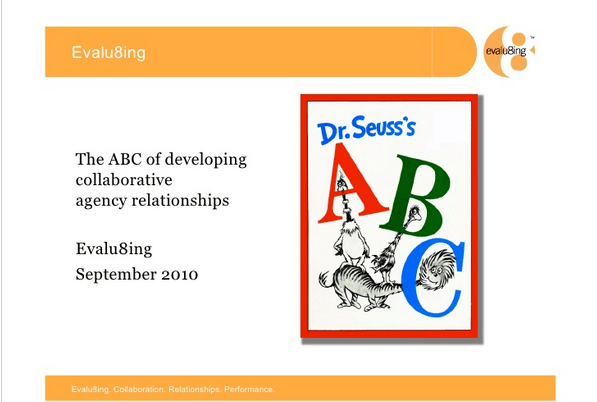Three years ago I was invited to talk to the ISBA COMPAG group on developing and managing collaboration between agencies. This has been a focus for me personally and for TrinityP3 since 2005, when we noticed that one of the big challenges for many marketers was managing their roster of agencies, while most processes and systems looked at only individual supplier relationships and not how to manage these more holistically.
This led to the development of the Evalu8ing system, which allows marketers and procurement to manage the multiple relationships that exist between marketing and their roster of agencies in one survey and one system. The process of using Evalu8ing with our clients has led to insights into the key elements required to create a collaborative environment, or at least a cooperative environment within the agency roster.
Taking a page out of the writings of one of my favourite authors, I was able to present this as the ABC of developing collaborative agency relationships – with grovelling apologies to Dr. Suess.
Here I want to revisit this presentation and expand and update some of the observations in that original presentation, which is here for reference. lets start at the beginning…
BIG A little a what begins with A?
Arrangements
With so many channels and so many specialist agencies, it seems that agency rosters can multiply like coat hangers in your wardrobe. This is because the roster structure evolves organically rather than being strategically planned. What I mean by this is that agencies are often added in response to an immediate need. This is a tactical approach to roster management and means that the suppliers within the roster often do not see a strategic requirement for their services so they are competing for their place in the roster.
While some marketers and procurement people see this as a power advantage, the fear and uncertainty this creates in the suppliers is counterproductive to creating collaboration which is heavily based on trust. Not to mention counterproductive for creativity which likewise requires a high level of trust. This does not mean you cannot have a competitive roster. It is simply that competition in the roster should be positive and not ever at the expense of the trust between the marketers and the agencies.
Alignment
The game Tug-o-War is a prime example of what can be achieved if a team of people are aligned. However alignment does not occur naturally in large groups of individuals or between multiple teams. Simply putting teams of people together will not create alignment. In fact depending on the diversity of the people within the teams and the diversity between the groups, alignment can be almost impossible unless you create some common, specific, measurable, achievable, short term objectives to which people can align themselves.
In the ideal situation, these would be the short term goals determined in the marketing strategy and then interpreted and defined for each of the agencies to deliver against. This alignment is also encouraged where all of the teams within the roster share in a success based reward.
Assessments
If you achieve alignment, you cannot simply rely on everything running smoothly. Of course, where it is small teams, it is easy to check in to ensure the relationship is on track. But larger teams and especially where there are multiple marketing teams within the organisation, all accessing and interacting with the same group of agencies on the roster, it is important to have a more rigorous and structured review process and the discipline to regularly review the relationships.
Interestingly, the type of process you use can influence the level of collaboration. You see in many cases people use performances based score cards and questions, where the criteria is specific to the performance of the individual agencies. There is a score card for media and a score card for digital and a score card for creative. This approach immediately positions the agency as a supplier and the marketer as a buyer. It reinforces the power game between the two and often leads to ‘scoring’ points off the agency with low scores.
The other issue is that different score cards for different disciplines focuses the agencies on their personal performance and away from the concept of the collaboration for the benefit of the collective group. This is why all parties should be assessed against common, consistent criteria with a true 360º approach where the marketer is also evaluated based on the same criteria. This is one of the fundamental principles of Evalu8ing as it creates a perfectly even playing field devoid of the power plays so common in other relationship score cards and surveys.
Big B little b what begins with B?
Bonus
Most agency remuneration models are counter collaborative as they recognise and reward the volume of work undertaken by the agency and not the results delivered. If you are rewarding agencies for the volume of the work they undertake, then you will find that each agency will be competing for more work as a way to increase their revenue. And in an environment of a limited budget it means they are competing with each other for a share of that budget.
This type of competition works against collaboration as each agency is working on bettering their position at the expense of the other agencies you want them to collaborate with. Instead, the bulk of the remuneration should focus on rewarding all the agencies collaborating together for achieving their and hopefully your common goal. The focus should be placed on having all parties align to a measurement of success.
Bonding
There are a lot of technology companies making a fortune out of selling technology solutions for collaboration. But as my colleague Shawn Callahan at Anecdote has found, there are many reasons these collaboration tools fail to get traction with human beings. And that is a key point about collaboration. It is about relationships between human beings. Collaboration requires those groups of people to share values, share expectations and share their goals and objectives. This requires a high level of trust. Interaction, talking and sharing these objectives provides the opportunity to share learnings from successes and failures. This sharing and bonding builds trust.
The problem is that many times these ‘bonding’ opportunities only occur with account management, and often at the most senior level. Here there are financial and relationship agendas as the account management team of each agency is responsible and held accountable for the profitability and financial growth of the account. Instead, marketers should encourage agency teams to share and bond at all levels and across all disciplines within their agencies. In my experience this is especially effective in creative and production, where the focus is more on outcome than financial performance.
Boundaries
Following on from Arrangement, is the need to set very clear operating boundaries. Often when agencies are appointed to fulfill a tactical need there are no clear boundaries set up in the engagement. This can first of all lead to the incumbent agencies on the roster feeling threatened and secondly the new agency unknowingly overstepping their area of responsibility increasing the perceived threat. This leads to turf wars with the agencies becoming more focused on defending their patch and share of budget and trying to take a share of budget from the other agencies.
To stop turf wars requires rules of engagement in contracts. There needs to be very clear and defined roles and responsibilities. This is not simply in regard to disciplines and services, but also in defining process. We have found that the Engagement Agreement process is an ideal way to work with the agencies to define these role, responsibilities and boundaries, but it also sets expectations and allows the agencies to own the process.
Big C little c what begins with C?
Capabilities
One of the ways agencies are trying to increase revenue is in the diversification of their services and capabilities. This is sometimes achieved through acquisition of another specialist agency or grown through recruitment of key agency staff. But it is almost impossible for any one agency to excel at all of the disciplines they say they provide.
The problem for marketers is in determining what is the core competency of their agency and what is simply a bolt-on competency in an attempt to capture more of your budget. In determining the core capabilities, the best way is to talk with the agencies’ other clients, who use these services and see what they think of the quality. Another way is to simply have the agency present case studies on a regular basis of what they have delivered for others. The main thing is to judge the agency’s core competencies through action not words.
If a rostered agency demonstrates a new competency that allows you to potentially consolidate your roster and remove a specialist, then simply undertake a limited review of that capability between the two in a structured and transparent way. Any other approach and you will encourage distrust and suspicion between the agencies on your roster.
Communication
Of course great communication is essential for collaboration. But I want to specifically focus on disputes and dispute resolution. This is because I believe that creativity is like sand in the oyster that creates the pearl, creativity and innovation is prickly by nature and can cause irritation. But managed properly this can create valuable enduring and productive relationships. Therefore a dispute resolution process is essential.
When disputes arise, rather than ignoring these and hoping they go away, it is far more effective to create a forum that allows a free exchange of concerns on issues. This collective ownership of the problem will often produce ideas and innovations that enrich the relationships, the process and ultimately the marketing outcomes.
And Culture
In the original presentation my last C was collaboration itself. And I reiterated the importance of managing the process by establishing rules and regular management. But more importantly than this is Culture. Collaboration is not simply a process. You can implement a process but that will not mean you will get collaboration.
Collaboration is where two more parties have agreed to work together to achieve a mutual goal where all parties share in the value created. This requires the presence of a culture of collaboration. It means developing mutual trust and shared values. Because if you do not have a desire to share the value of the outcomes you will at best have cooperation or at worst simply coordination. But essential to collaboration is a culture that builds and maintains mutual trust between all parties.
Interested to hear your views on getting collaboration between agencies. Leave a comment with your thoughts.




